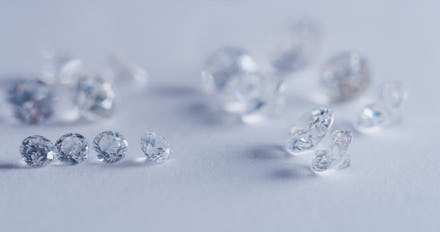Pandora, the world's largest jewelry company, will no longer use mined diamonds

As a wildly popular gemstone, diamonds are often associated with good times. They're often the immediate go-to for wedding bands or engagement rings and other special occasions. Yet the process of mining diamonds takes a huge toll on not only the environment, but the people tasked with their extraction. In a move towards ethical sustainability, Pandora announced it will no longer use mined diamonds. Instead, the company is turning its focus to their manufactured alternatives.
In 2019, the diamond jewelry market was valued at about $79 billion worldwide, and it's expected to continue growing. However, longtime concerns over the diamond trade's impact on human suffering, and its links to ecological devastation, have prompted conversations on whether it's a market that should exist at all. On Tuesday, Pandora, the world's largest jewelry company, launched its first lab-created diamond collection, Pandora Brilliance.
The collection's launch is part of the company's goal to make diamonds more affordable for the general public. In a statement, Pandora CEO Alexander Lacik said, "Pandora continues its quest to make incredible jewelry available for more people, and today I'm proud to announce the introduction of Pandora Brilliance. It's a new collection of beautifully designed jewelry featuring lab-created diamonds."
Per CNBC, Pandora alone made 85 million pieces of jewelry last year and sold 50,000 diamonds. So the company deciding to completely abandon mined diamonds is no small thing. And in its announcement, Pandora stated its lab-created diamonds are certified carbon neutral. In addition, lab-created diamonds are identical to mined ones and graded with the same 4C standards — cut, color, clarity, and carat.
Lab-created diamonds have been growing in popularity; by 2030, the global market volume is expected to be around 19.2 million carats. Part of this growth has to do with advanced technology allowing companies to make better — and cheaper — product. A report commissioned by the Antwerp World Diamond Centre found that in 2018, it cost $300 to $500 per carat to make a lab-grown diamond, compared to the $4,000 per carat it cost in 2008. So while there might be an ethical and environmental argument to be made for lab-created diamonds, there's also a bottom line-friendly one too.
In response to lab-created diamonds' popularity, traditional miners have pushed back with claims that these diamonds are, actually, more carbon intensive. In 2019, the U.S. Federal Trade Commission went warning letters to eight lab-created diamond companies, citing concerns over their use of the label "eco-friendly" and other similar terms. But as Alan Septoff, the strategic communications director at Earthworks, told Vogue Business, "It's not surprising that a report funded by diamond miners determines that mined diamonds are better than lab-grown diamonds."
Regardless, Pandora's move to using lab-created diamonds only will certainly quiet some of the internal squabble. And the move symbolizes quite a lot. Lacik said, "[Lab-created diamonds] are as much a symbol of innovation and progress as they are of enduring beauty and stand as a testament to our ongoing and ambitious sustainability agenda. Diamonds are not only forever, but for everyone."